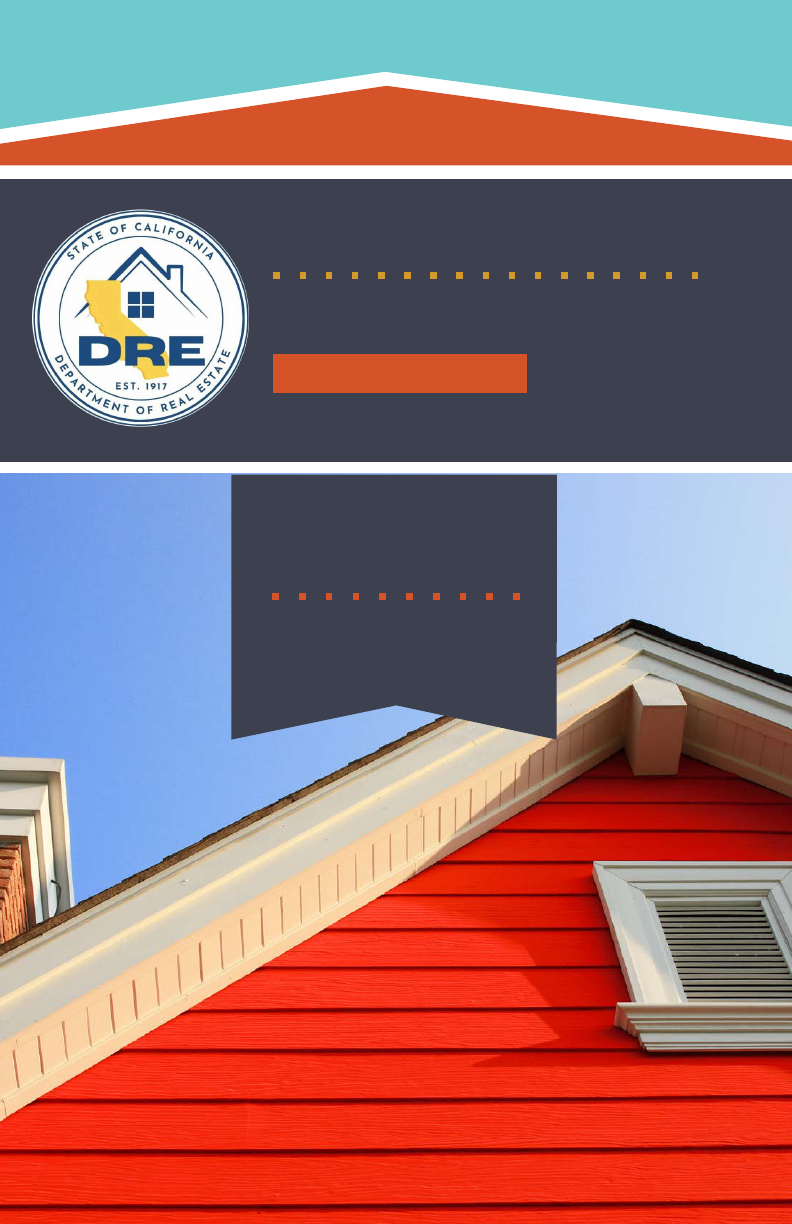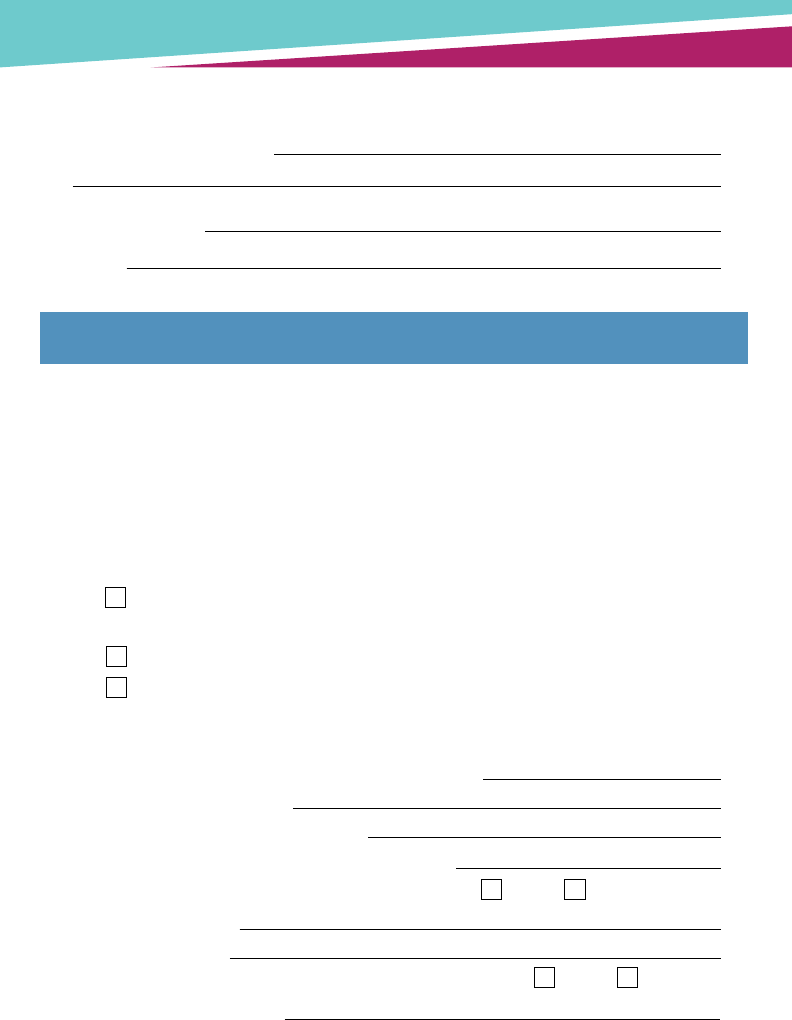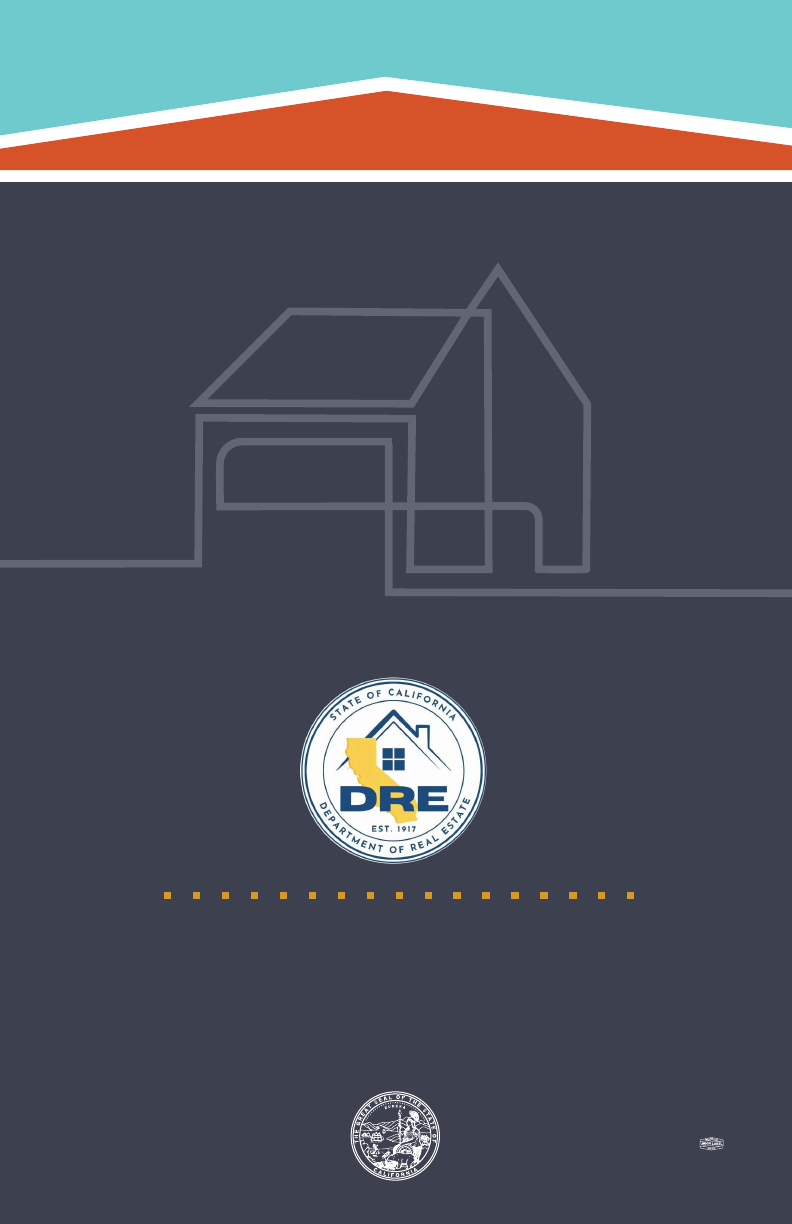
Loan Modification Self-Help Guide A
LOAN MODIFICATION
MAY 2020
SELF-HELP GUIDE
You can obtain your
own loan modification.
Make it your mission
to save your home.

B State of California Department of Real Estate

Loan Modification Self-Help Guide 1
I. WHAT IS A LOAN MODIFICATION AND DO I QUALIFY?
Description of a Loan Modification
A loan modification is a restructuring of your current loan repayment
period (term), interest rate, or other provision of your home loan.
Occasionally, some of the principal balance of your existing loan may
be forgiven and/or your loan term could be extended. You may have
also heard the term “forbearance plan,” which is a restructuring of or
postponement of payments. New loan terms under a loan modification or
forbearance plan are meant to provide you with an opportunity to stay in
your home while making aordable payments for the life of the loan. They
are tools to help you avoid foreclosure if you are willing to make payments
and have the income to sustain aordable payments. For purposes of this
guide, a forbearance plan and a loan modification are synonymous.
Do I Qualify for a Loan Modification?
■ You must be able to substantiate consistent and sucient
income to cover your new payments. If you do not have
consistent income to be able to make the new payment
under the loan modification, your request will likely be denied.
A new proposed monthly payment on a loan modification
(including your property taxes and insurance) should be
about 31% or less of your monthly income.
■ You cannot currently be in a bankruptcy proceeding (unless
otherwise advised by your bankruptcy attorney).
■ If the home is not your primary residence, your loan
modification request will likely be denied.

2 California Department of Real Estate
Alternatives
■ Request a forbearance plan from your mortgage lender.
This program is a formal, temporary, written agreement with your
mortgage lender designed to temporarily stop foreclosure
proceedings. It is not a complete loan modification and is usually
used when your inability to make payments is temporary, such as
when you sustain a major illness or injury.
■ Consider increasing your income by taking on a second job.
■ Consult with a bankruptcy attorney to understand all of
your options.
■ Speak to a local real estate agent regarding a short sale.
In a short sale, an arrangement is negotiated with your mortgage
lender to sell your home for less than you owe on the loan.
Understand that a short sale can have negative consequences.
Other than selling your home and satisfying the loan, there are
no benefits to your credit for obtaining a short sale. When
you attempt to purchase another home after obtaining a short
sale, the mortgage underwriter for the new loan will likely treat
the short sale the same as a foreclosure. Multiple mortgages on
your property could prevent a short sale.
■ A deed in lieu of foreclosure can be an option in the event
you have decided you can no longer aord your home and
do not want to go through marketing eorts or foreclosure.
With a deed in lieu of foreclosure, you ask your lender if
they will take title to your property, subject to existing claims
or liens, instead of foreclosing. Note that the lender may decide
a foreclosure is a better option for them and reject your oer
to issue a deed in lieu of foreclosure.

Loan Modification Self-Help Guide 3
Expectations
■ While you can obtain your own loan modification,
it is usually time-consuming and tedious. You must be persistent
with your mortgage lender. When possible, communication
with your lender should be in writing. If you talk on the phone to
a representative of your lender, be sure to document the name of
the person you spoke with, the date and time of your conversation,
the phone number, and all information you received.
■ A successful loan modification could take several months,
so be sure to return all requested information and
documentation to your mortgage lender in a timely manner.
Maintain a file of all documents received and all delivery receipts.
■ Your lender may request that you have your home appraised by
a licensed real estate appraiser or evaluated by a licensed real
estate broker.
■ Once you receive the final loan modification paperwork,
you can also expect that the initial loan modification will be
for a trial period of usually a few months. After you have made
all scheduled payments on time, your trial period will end
and your loan modification will become permanent. If you were
considering selling your home, you would have to wait for your
loan modification to become permanent. Have a real estate
attorney or real estate broker review the terms of your loan
modification prior to listing your home for sale.
II. LAWS SURROUNDING LOAN MODIFICATIONS
■ In October 2009, Governor Arnold Schwarzenegger signed
Senate Bill 94 (Calderon) which prohibits any person, including
real estate agents, mortgage brokers, and lawyers, from
demanding, charging, or collecting an advance fee for loan
modification services prior to the completion of those services.
If you are approached by any person requiring upfront fees for
loan modification services, do not pay them.

4 California Department of Real Estate
■ Eective January 31, 2011, the Federal Trade Commission
issued a rule with nationwide eect that bans providers of
Mortgage Assistance Relief Services (“MARS”), which includes
residential mortgage foreclosure rescue, loan modification, short
sale, and deed-in-lieu of foreclosure services from requesting or
collecting fees or other consideration from a homeowner until the
consumer has executed a written agreement with the loan holder
or servicer incorporating the oer of mortgage relief the provider
obtained from the loan holder or servicer. The rule also mandates
that providers of MARS disclose to consumers the total cost of
the services, that they have no connection to any government
program or agency, and that homeowners are free to reject any
oer from the lender or servicer with no requirement to pay a fee
to the MARS provider. The rule also bars providers of MARS from
distributing false or misleading information, and from advising
consumers to stop communicating with their home loan lenders
or servicers.
■ Eective July 2013, the Homeowners Bill of Rights (“HBOR”) was
enacted to give borrowers and homeowners facing foreclosures
various statutory protections. For instance, the law prevents
“dual-tracking,” which occurs when a mortgage lender or servicer
proceeds with the foreclosure process at the same time that they
consider a homeowner’s loan modification application. The
HBOR also requires servicers to assign an applicant with a single
point of contact to utilize throughout the application process. If a
loan modification is denied, the HBOR requires the servicer to
identify the reasons for the denial in writing, and give the applicant
a chance to appeal the denial before proceeding with the
foreclosure. If you have been denied a loan modification, consult
an attorney to ensure you were aorded all of the protections
under the HBOR.

Loan Modification Self-Help Guide 5
III. HOMEOWNER BEWARE
■ Most mortgage lenders collect your payments and forward
them to the investor that actually owns your loan or note. This
process is known as servicing the loan. Ask if your mortgage
lender is only a servicer, and, if so, ask them for contact
information for the investor that actually owns your loan or
note. Generally, the note owner must approve a loan modification
that is negotiated between you and the servicer.
■ Do NOT stop making your mortgage payments payments
in order to “qualify” for a loan modification. This can
severely damage your credit and trigger the start of the
foreclosure process.
■ If you have a first and second mortgage (or even a third), you
may have dierent mortgage lenders. You must contact all
of your mortgage lenders before entering into a loan modification.
When you have multiple mortgages on your home, working out
a loan modification with one mortgage lender does not bar the
other mortgage lender(s) from proceeding with a foreclosure.
■ A short sale does not necessarily look better on your credit report
than a foreclosure. It also may not free you from the balance
you owe, leaving you with what is called a deficiency balance.
Although recent changes to the tax codes generally prevent
a short sale from being considered a taxable event, you should
consult a tax professional about the possible tax implications of
a short sale.
■ IF YOU ARE APPROACHED BY ANY PERSON REQUIRING
UPFRONT FEES FOR LOAN MODIFICATION OR SHORT SALE
SERVICES, DO NOT PAY THEM AND CONTACT THE
DEPARTMENT OF REAL ESTATE AT (877) 373-4542.
■ Understand that your lender may not agree to a loan modification.
You are requesting a change to the loan terms to which you
and the lender already agreed. There is no obligation for the
lender to approve your request for any change, and the loan
modification request may be denied.

6 California Department of Real Estate
IV. PREPARATION BEFORE CALLING YOUR
MORTGAGE LENDER
STEP 1:
Before you contact your mortgage lender, you should gather all of
the necessary documentation found on the “Items to Deliver to Your
Mortgage Lender” checklist.
STEP 2:
You need to determine the estimated current market value of your
home. You can do this dierent ways, including:
1. Search your property address on a reliable property
valuation website.
2. Contact a local real estate broker.
3. Contact a local appraiser.
You should note that some of the methods above may require
payment. You will need to do research to determine whether any of
these services are oered for free in your area.
STEP 3:
Once you have completed steps 1 and 2 above, you are now
prepared to contact your mortgage lender and speak to them
intelligently with all of the information in front of you. Call the
customer service phone number listed on your mortgage statement
and ask for the loss mitigation department, the loan modification
department, or the foreclosure prevention department (which
all refer to the same department). Follow the instructions of the
representative that you speak to and be sure to take notes (write
everything down) and ask questions.

Loan Modification Self-Help Guide 7
(continued on page 8)
Homeowner Name(s):
Loan Number:
Date:
CHECKLIST OF ITEMS TO DELIVER TO YOUR MORTGAGE LENDER
Use the following checklist as a guide when gathering the necessary
documentation. Your mortgage lender will require you to provide this and
perhaps other information when requesting a loan modification. You may
want to include a copy of this checklist with your documents. Mark each
page of each copy with your identifying information. Be sure to send only
copies and not the original documents.
1. Current mortgage loan statement.
2. Original mortgage loan documents including:
NOTE
DEED OF TRUST
Record the following information here:
Term of your loan (30 years, 15 years, etc.):
Current interest rate:
Is the rate fixed or adjustable?
Are you making interest only payments?
Will there be a balloon payment due? Yes No
If yes, when?
How much?
Is there a prepayment penalty on the loan? Yes No
If yes, how much?

8 California Department of Real Estate
3. Information you have obtained regarding the current market value
of your home.
4. Current paystubs covering the past two months for all homeowners.
5. All W-2s and/or 1099 forms for the most recent tax year for
all homeowners.
6. All pages of your income tax returns for the most recent tax year
for all homeowners.
7. At least two months’ proof of any other forms of income such
as: benefits or awards letters, retirement or pension benefit
statements, annuity statements, child support and/or alimony
received (include court order and proof of receipt of payment),
any other forms of income.
8. All pages of your most recent bank statements covering the past
two months.
9. Hardship Letter – A personal statement written, signed, and
dated by all homeowners describing the hardship that serves as
the basis for the loan modification you are requesting.
(check list continued from page 7)(check list continued from page 7)

Loan Modification Self-Help Guide 9
V. WHEN YOU RECEIVE YOUR LOAN MODIFICATION
PAPERWORK
Be sure to:
1. Understand all of the terms including the type and terms of your loan,
your new interest rate, and payment.
2. Review and confirm that all of your personal information is correct.
3. Contact your mortgage lender immediately if there is an error.
4. Sign the documents exactly as your name appears on the paperwork.
5. Have your signature notarized (only if required by your
mortgage lender).
6. Keep copies of all the documents before you send them back.

10 California Department of Real Estate
VI. OTHER RESOURCES
If you have other questions or need further assistance with your loan
modification process, contact the following non-profit agencies:
■ Homeownership Preservation Foundation (HPF)
3033 Excelsior Boulevard, Suite 500
Minneapolis, MN 55416
www.995hope.org
(888) 995-4673
(612) 230-4020
■ HUD Counseling
www.hud.gov
(800) 569-4287
For more consumer publications, visit the California Department of Real
Estate at: www.dre.ca.gov.

Loan Modification Self-Help Guide 11
VIII. GLOSSARY OF TERMS
Advance Fees – any money that is claimed, demanded, charged,
received, or collected up front in promise of services to be done before
those services have been completed
Appraisal – a written evaluation of the current market value of your home
completed by an appraiser
Balance of Your Loan Forgiven – a portion of the loan balance is erased
and that part of the debt against your home is erased
Balloon Payment – an oversized or lump sum payment due at the end of
the mortgage term
Current Market Value – the amount of money your home would bring
if you sold it today in the current, local market; the highest amount any
buyer is currently willing to pay for your home today
Deficiency Balance – the amount left over from the amount the money
an investor or mortgage lender receives from the sale of their foreclosed
property that is insucient to pay o the full loan balance
Foreclosure – A process by which an investor or mortgage lender sells
your home at a sale auction in order to pay o your loan balance and
reclaim their collateral (your home)
Mortgage Underwriter – a person working for an investor or mortgage
lender that reviews your mortgage loan application or loan modification
request, along with all of the supporting documentation you provided, to
determine if you qualify for the loan or modification, and evaluate the risk
to the investor or mortgage lender
Prepayment Penalty – a fee or charge that is assessed to the borrower if
they pay their mortgage loan balance o early, before the end of the term
specified in the penalty
Term of Loan – the length of time set to pay o a loan; usually mortgages
are set for 15-year, 30-year, or 40-year terms



